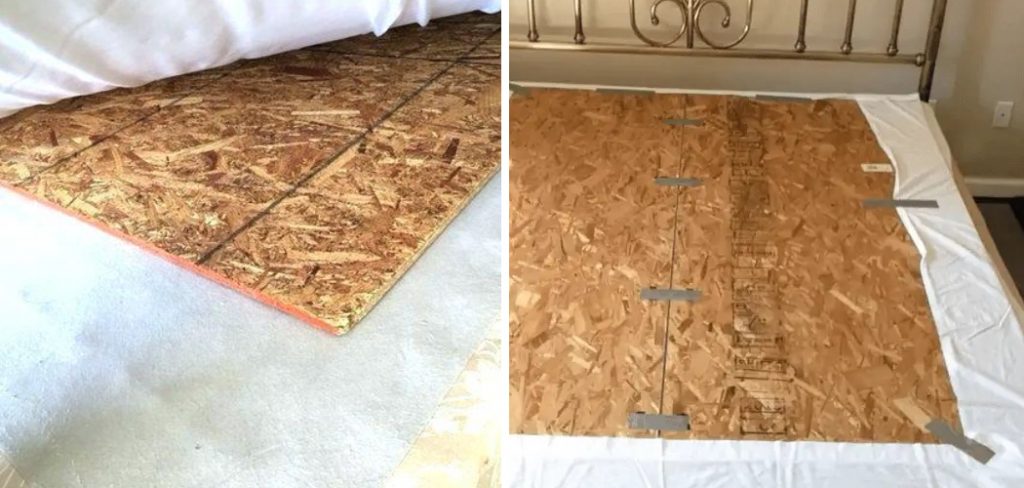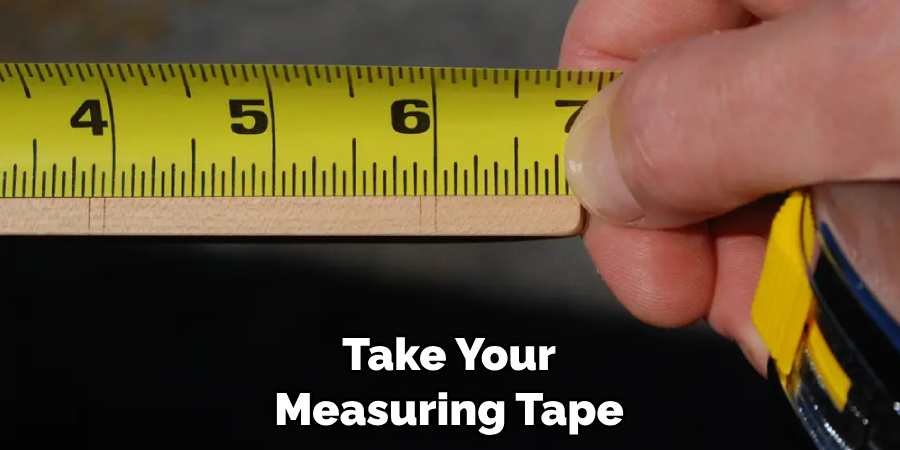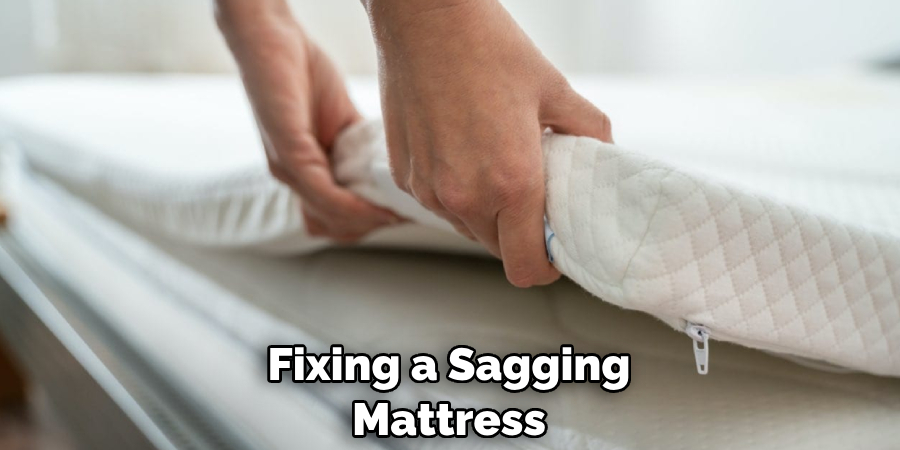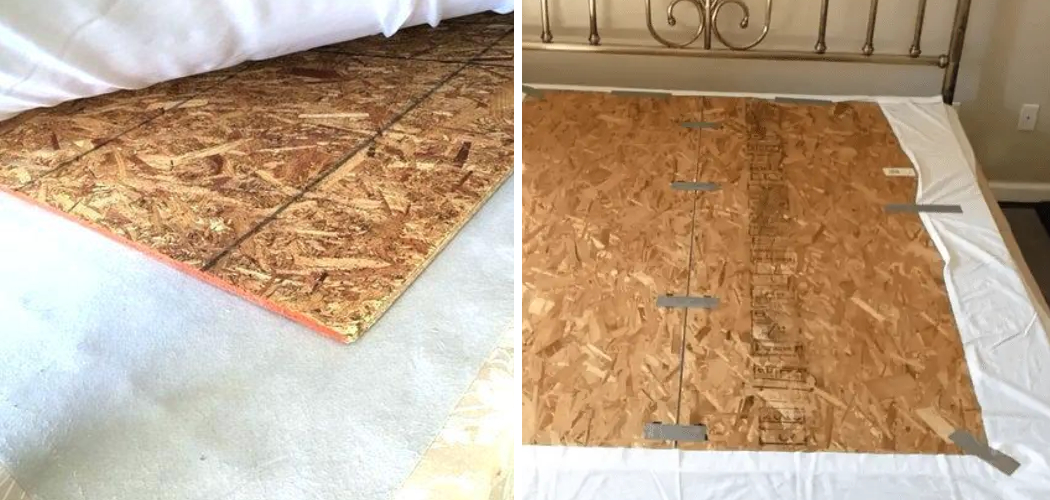Are you tired of waking up with a sore back? A sagging mattress can put an uncomfortable strain on your body while you sleep. Luckily, an easy solution is fixing a sagging mattress with plywood. In this article, we will go over the steps to do just that.
There’s no worse feeling in the morning than rolling over and sinking into a sagging mattress. You toss and turn a few times before eventually resigning to an uncomfortable night’s sleep on your lumpy bed.

However, you don’t have to suffer through it! You can fix that sagging mattress With plywood, bungee cords, and basic tools. Pretty soon, you’ll be sleeping comfortably again – here’s how to fix a sagging mattress with plywood!
What Will You Need?
- Plywood (Check with your local hardware store for the right size and type for your mattress).
- Bungee cords.
- Measuring tape.
- Power drill.
- Screwdriver or drill bit attachments.
- Sandpaper (optional).
Once you’ve gathered the necessary supplies, you can fix your mattress with plywood.
8 Easy Steps on How to Fix a Sagging Mattress With Plywood
Step 1: Measure Your Mattress
The first step in fixing your sagging mattress with plywood is to determine the exact dimensions of your mattress. Take your measuring tape and carefully measure your mattress’s length, width, and height.
Be sure to measure at several points to account for any irregularities or especially saggy spots. Write down these measurements, as you’ll need them when purchasing your plywood.
Step 2: Purchase and Prepare Your Plywood
With your mattress measurements, head to your local hardware store to purchase your plywood. Ideally, you’ll want a piece about 1/2 inch to 3/4 inch thick. Make sure the plywood is cut to match the dimensions of your mattress.
If your hardware store offers cutting services, this can be a time-saver. If not, you’ll need to cut the plywood yourself using a circular or table saw. Be sure to sand the plywood’s edges to prevent splinters or rough spots that could damage your mattress.

Step 3: Insert the Plywood
Lift your mattress and place the plywood between the mattress and the box spring. It’s best to have a helper for this step to ensure the plywood doesn’t slip or shift out of place.
Once the plywood is properly positioned, lower your mattress back onto the plywood. The plywood will act as a firm base, helping to distribute your weight evenly across the mattress and eliminate sagging spots.
Step 4: Secure the Plywood
Now that the plywood is in position, you’ll want to secure it to the box spring to prevent it from moving around. This is where the bungee cords come in. Use your power drill, screwdriver, or drill bit attachments to drill holes into the plywood and box spring.
Make sure the holes line up and are evenly spaced. Thread the bungee cords through the holes and secure them tightly. This will keep the plywood in place, providing consistent support to your mattress.
Step 5: Test Your Mattress
Once the plywood is secured, it’s time to test out your newly supported mattress! Lie down on the mattress and move around to different positions. The mattress should feel noticeably firmer, and the sagging areas should be significantly reduced.
If there are still sagging spots, you may need to adjust the positioning of the plywood or add additional plywood supports.
Step 6: Make Adjustments If Needed
If, after testing the mattress, you still feel uncomfortable spots or areas where the mattress appears to sag, don’t worry. The process allows for adjustments. Lift the mattress and examine the positioning of the plywood. Ensure it’s placed evenly across the box spring.

Adjust the bungee cords for a tighter fit or reposition the plywood so it offers better support in areas where you need it most. Once you’re satisfied with the placement and support, return the mattress to its place.
Step 7: Implement Regular Maintenance
Maintaining the rigidity of your mattress over time is crucial. Regularly check the positioning and condition of the plywood. Make sure it’s still secure and hasn’t shifted under the mattress. Additionally, keep an eye on the bungee cords to ensure they’re still providing adequate tension.
Make necessary replacements or adjustments if any aspect of your plywood support system seems worn or isn’t functioning as effectively. This will help prolong the life of your mattress and keep it comfortable for many nights to come.
Step 8: Enjoy Your Improved Sleep Quality
Now that you’ve successfully fixed your sagging mattress with plywood, it’s time to enjoy the fruits of your labor. You should notice a significant improvement in your sleep quality thanks to the added support to your mattress. No more waking up with aches and pains due to a saggy mattress!
Remember, a good night’s sleep is crucial for your overall health and well-being. You’re investing in your long-term health by taking proactive steps to maintain the quality of your sleeping surface.
By following these eight steps, you can easily fix a sagging mattress with plywood. With just the right supplies and effort, you can restore your sleeping surface to its former glory and get back to enjoying a good night’s sleep. So don’t wait any longer – start fixing that sagging mattress today!

5 Additional Tips and Tricks
- If you are using plywood to fix a sagging mattress, make sure it is cut to the exact size of your mattress. If it’s too big or too small, it will not be able to provide the necessary support and can make the problem worse.
- It’s important to use plywood of good quality so that it is strong enough to support the mattress.
- If your bed frame is made of metal, you can use a thin sheet of plywood to provide extra support and prevent the mattress from sagging.
- Be sure to place the plywood carefully on top of your mattress before adding sheets or blankets so that it won’t cause any discomfort when lying down.
- Make sure to check the condition of your mattress regularly, and if necessary, repeat the process to ensure that it still provides adequate support.
By following these simple steps, you can easily use plywood to fix a sagging mattress and enjoy a good night’s sleep.
5 Things You Should Avoid
- Do not use plywood that is too thick, as it will cause the mattress to become uncomfortable.
- If your bed frame is made of wood, do not place the plywood directly on it, as this can weaken its structure over time.
- Do not cut corners when cutting the plywood for your mattress—a wrong-sizedpiece of wood won’t provide any support.
- Do not overdo it by adding too many layers of plywood, as this can cause the mattress to become too hard.
- Avoid using a sub-par quality of plywood for your mattress—it might not be strong enough to hold up the weight of the mattress and will need replacing soon. By avoiding these common mistakes, you can ensure that your plywood fix will last long.
By avoiding these common mistakes, you can ensure your mattress is supported and comfortable for a long time. With just a few simple steps, plywood can fix sagging mattresses and provide the necessary support for a good night’s sleep.
Is It Bad to Sleep on a Sagging Mattress?
Yes, it can be bad to sleep on a sagging mattress. A sagging mattress that isn’t properly supported can cause possible health issues such as back pain and poor posture.
Sleeping on a sagging mattress can lead to interrupted sleep due to discomfort. Therefore, it’s important to take action and fix the issue quickly before it becomes worse.
Overall, fixing a sagging mattress with plywood is an easy and cost-effective way to provide the necessary support, improve your sleep quality, and ensure that your mattress lasts for years to come.

How Much Sagging is Normal in a Mattress?
The amount of sagging in a mattress is called its indentation load deflection (ILD). Normal ILD ranges from 10-15; any higher than this could be considered too much sagging.
However, it’s important to note that the sagging rate depends on the mattress type and material used. For example, foam mattresses tend to sag more quickly, so checking the ILD regularly and making any necessary adjustments is important.
Overall, if your mattress has an ILD higher than 15, it is recommended that you take action and fix the sagging issue as soon as possible. By doing this, you can ensure a comfortable sleep experience and maintain a healthy posture.
Conclusion
As we have seen, how to fix a sagging mattress with plywood is a practical solution. Depending on the amount of sagging, and the skill level of the DIYer, it can be an easy and inexpensive repair.
However, if you prefer not to do the work yourself, it will cost more, but a professional will guarantee it’s done correctly. It’s important to ensure that you take proper safety and health precautions when working on your bedding furniture to ensure the result is secure and stable.
Regardless of which route you choose – adjusting or replacing – with a little effort, you can quickly make your mattress look as good as new again. Be sure to research carefully and find out what would work best for you to ensure your sleeping area remains comfortable and inviting for many years.
